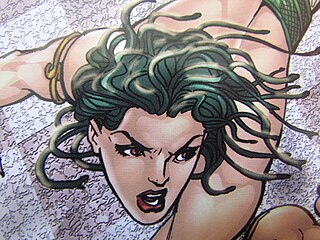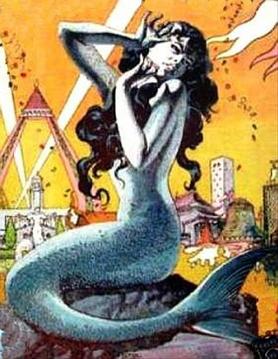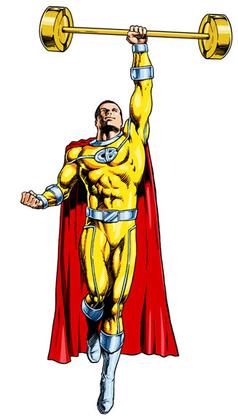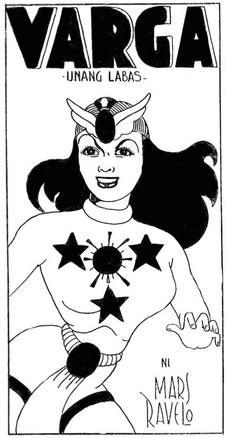Related Research Articles
Darna is a Filipina superheroine created by writer Mars Ravelo and artist Nestor Redondo. The character's first appearance was in Pilipino Komiks #77 on May 13, 1950. Darna is a retooling of Ravelo's earlier character, Varga, whose stories he wrote and illustrated himself. This character first appeared in Bulaklak Magazine, Volume 4, #17 on July 23, 1947. Ravelo left the Bulaklak Magazine publications due to differences with the publication's editors. One of the most popular Filipino superheroes, Darna has appeared in many films and several television series through the decades which have far overshadowed her actual comics tenure.

Marcial "Mars" Ravelo was a Filipino comic book cartoonist and graphic novelist who created Darna, Dyesebel, Captain Barbell, Lastikman, Bondying, Varga, Wanted: Perfect Mother, Hiwaga, Maruja, Mariposa, Roberta, Rita, Buhay Pilipino,Jack and Jill, Flash Bomba, Tiny Tony, and Dragonna among others.

Valentina is a supervillain created by Mars Ravelo and Nestor Redondo who first appeared in the second episode of the Darna series published in the Philippine comics Pilipino Komiks. One of the most recognizable supervillainess characters in the Philippines, she is the archenemy of Darna. She was originally a bitter, deformed woman born from ordinary human parents with venomous snakes on her head that appears to be like hair. When she grew up, she killed her parents and was subsequently taken in by a serpent creature named Kobra. Valentina was soon referred to as "goddess of the snakes".
Comics in the Philippines have been widespread and popular throughout the country from the 1920s to the present. Komiks were partially inspired by American mainstream comic strips and comic books during the early 20th century. The medium first became widely popular after World War II. Its mainstream appeal subsided somewhat during the latter part of the 20th century with the advent of other mass-media forms such as telenovelas, but experienced a renaissance in the mid-2010s with the increasing popularity of artists such as Gerry Alanguilan, Arnold Arre, Budjette Tan, Kajo Baldisimo, and the rise of fan communities through comic book conventions such as komikon. Webcomics produced by independent Filipino web-based artists have caught the attention of local and foreign readers.

Komiks is a Philippine television fantasy-drama anthology broadcast by ABS-CBN from February 4, 2006, to August 8, 2009, replacing My Juan and Only and was replaced by Agimat: Ang Mga Alamat ni Ramon Revilla. The series features popular local comic book stories by comic writers Pablo S. Gomez, Francisco V. Coching, Mars Ravelo, Elena M. Patron, and Jim M. Fernandez and airs on Saturday evenings.
Zuma is a Filipino comic book character created by Jim Fernandez in 1974. The character first appeared in a serial written by Fernandez entitled Aztec. From 1976 to 1985, Zuma got his own series named Anak ni Zuma that was serialized in Aliwan Komiks published by Graphics Arts Service Inc. with illustration by Ben Maniclang. The comics series was the biggest best seller for Aliwan. Following this publication success, spin-offs and a 1990s reboot about the character were published and it was further expanded in other media including film and television.

Dyesebel is a Filipino comic book character, conceived by Mars Ravelo and drawn by Elpidio Torres. Dyesebel is a mermaid, who eventually gains full human form through a deal with a sea-witch.

Captain Barbell is a Filipino superhero created by writer, Mars Ravelo and artist Jim Fernandez. His characteristics are similar to American fictional superheroes Superman, DC Comics' Captain Marvel or Shazam, and Thor but Ravelo based his backstory on Captain America. He first appeared in Pinoy Komiks #1 on May 23, 1963. He also appeared in Kampeon Komiks.

Varga is a Filipino comics superhero created by Mars Ravelo. He wrote and illustrated Varga for Bulaklak Magazine, appearing first in the magazine's No. 17, Vol. 4 issue. A falling out with some of the magazine's editors caused Ravelo to resign from Bulaklak and transfer to Pilipino Komiks, where he re-launched his superhero. Ravelo renamed her Darna, an anagram of the superhero's mortal alter-ego name Narda. Darna's adventures in Pilipino Komiks began in the No. 77 issue, where she was illustrated by Nestor Redondo.
Pablo S. Gomez, was one of the top komiks writers in the Philippines. He was also a screenwriter and director. His most popular works include Kurdapya and Petrang Kabayo among others.

Francisco V. Coching was a Filipino comic books illustrator and writer and is regarded as one of the “pillars of the Philippine Komiks Industry”. He served as both illustrator and writer for his comic book stories, Coching is referred to as the "King of Komiks", and as the "Dean of Philippine Comics". In 2014, he was posthumously conferred as a National Artist for Visual Arts, the highest honor for artists in the Philippines.
Federico C. Javinal is considered one of the “great achievers in Philippine Art”, particularly in the field of Philippine comics.
Antonio "Tony" Velasquez is a Filipino illustrator regarded as the Father of Tagalog comics and as the pioneer and founding father of the Philippine comics industry. He was the creator of Kenkoy, an “iconic Philippine comic strip character”.
Dominador "Hal" Santiago (August 9, 1941 – February 21, 2021) was a Filipino illustrator and writer in the field of Philippine comics. He was known in the comic book profession in the Philippines for his “artistic visualizations of various novels”. Santiago was described by Filipino writer Jim M. Fernandez as the “Raphael of [Philippine comic book] Illustrators”. His illustrations for eight comics series made him one of the most prolific Filipino comic illustrators, second only to Mar T. Santana, who has illustrated 17 series.
Elena M. Patron-de los Angeles, commonly known by her maiden name Elena Patron, was a Filipina scriptwriter, novelist, poet, dramatist, essayist, and magazine columnist. Patron was one of the few women in the Philippines who ventured and succeeded in writing for Philippine comics, a field that was dominated by Filipino male writers.
Virgilio "Virgil" Redondo y Purugganan was a Filipino comic book writer and artist.
Clodualdo del Mundo Sr. was a Filipino novelist, playwright, essayist, short story writer, journalist, screenwriter, teacher, critic. Many comics fans know him as the prolific writer of komiks through Liwayway and Ace Publications.
References
- ↑ Jesuits (1998). Philippine studies, Volume 46, Issue 2. Ateneo de Manila University.
- ↑ "Zuma". International Catalogue of Superheroes. Retrieved 7 March 2021.
- 1 2 3 4 5 6 7 8 9 10 11 Jim M. Fernandez by Komiklopedia on 2007/12/31
- ↑ "Tiny Tony". Philippine Comics. Archived from the original on 2016-12-06. Retrieved 20 February 2021.
- ↑ "Jim Fernandez". Lambiek's Comiclopedia. 30 April 2020. Retrieved 7 March 2021.